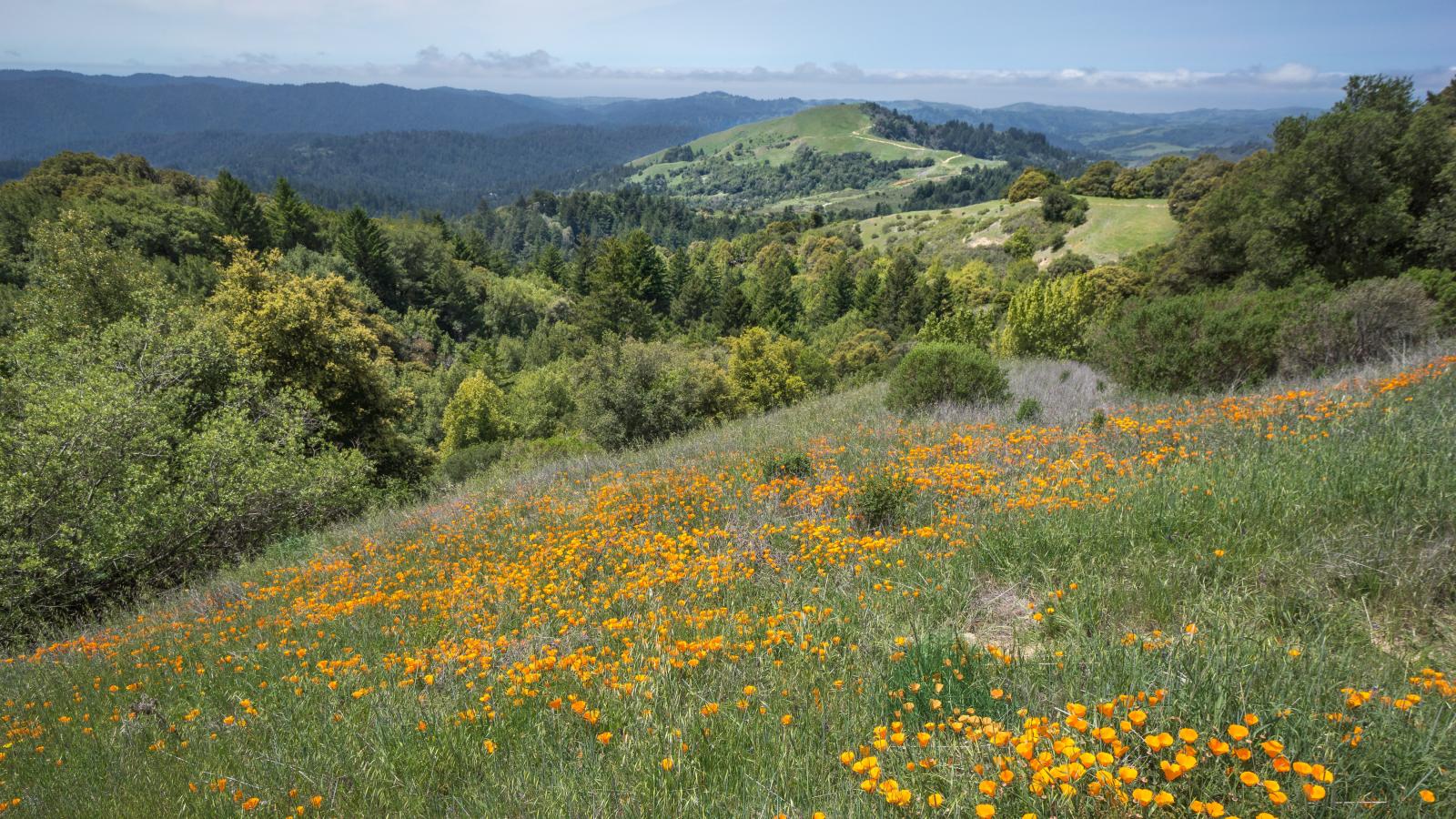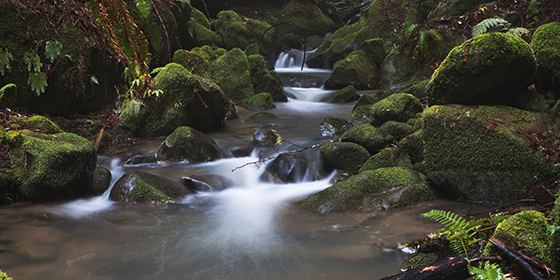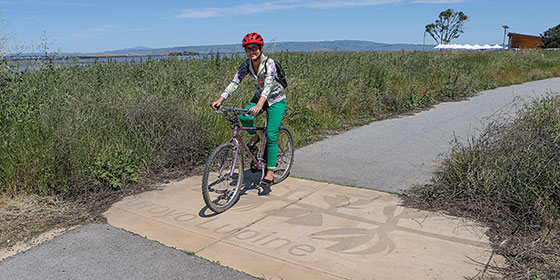Watersheds in winter, celebrating 15 years on the coast, open space community and more in our winter newsletter.
There are three ways to enjoy the quarterly newsletter: flip through the online version, scroll below to read, or download a pdf.
Watersheds in Winter
Midpeninsula Regional Open Space District boundaries encompass just over 350,000 acres on the peninsula, more than 15%, or nearly 65,000 acres, of which we’ve protected in perpetuity. It’s easy to recognize the dominant feature of these lands: the Santa Cruz Mountains. Harder to see, but perhaps more important, are the 11 major and six smaller watersheds that flow from these hills across Midpen preserves. Some of these, like the San Francisquito, flow east to the bay, while others, like the San Gregorio, flow west to the ocean.
Watersheds are defined by the land drainage area that channels water flow to a specific exit point. Regardless of the outlet, it’s important to keep our watersheds healthy to provide clean water for plants, animals and people.
With wide upper reaches that funnel to a narrow mouth, the San Gregorio watershed provides a clear example of how what happens in the upper area of a watershed can impact the land and water downstream. As the caretaker of El Corte de Madera Creek, La Honda Creek and Russian Ridge preserves, which make up about one-third of this watershed, Midpen has learned a lot about watershed protection.
The steep redwood-covered slopes at El Corte de Madera Creek Preserve, for example, were clear cut at the turn of the century. This unsustainable practice, combined with the construction of a network of dirt roads to get the logs out, created serious erosion that allowed soil to wash downstream and choke off spawning habitat for the now endangered coho salmon and threatened steelhead trout. The bare, scraped hillsides replaced healthy tree roots, duff and the soft, meandering paths of an undisturbed forest floor became slick, steep gullies and gulches. This increased the flow of water coming down the hillsides, rather than soaking into the ground.
“When we acquired El Corte de Madera Creek, it had a history of intense use that created a lot of sediment runoff into creeks,” explains Midpen Water Resources Specialist Aaron Hébert. “It needed major restoration to help heal the land and clean up the watershed.”
Midpen invested $1.25 million and thousands of hours of work over 15 years to complete the watershed protection program at El Corte de Madera, working on 24 miles of roads and trails — constructing bridges, repairing failing culverts, converting old roads to single-track trail or returning them to a more natural state.
“We inherited a legacy of issues,” Hébert said, “and people want public recreational access, so it’s challenging to try to balance everything for the health of the watershed that hosts important salmonids. This is the most substantial, longest-running watershed protection program Midpen has undertaken and preliminary monitoring indicates it’s working. Less sediment is entering the streams and downstream fish habitat has improved.”
Healthy watersheds are so important to the resilience of our communities that a host of public agencies are charged with watershed protection. Midpen collaborates with many partners for ongoing stewardship. Staff, contractors and volunteer crews replace invasive vegetation with native plants to promote deeper and more diverse root structures to hold soil in place. Large woody material is strategically added to creeks to create more salmonid spawning habitat. We also curtail operations in the winter and close trails when conditions are wet and muddy to avoid disturbances that can increase soil runoff.
You can help by following low-impact recreation best practices, obeying trail closures and volunteering as a preserve partner. We can all work together to keep our watersheds healthy at a landscape scale.
Learn more about the watershed protection program
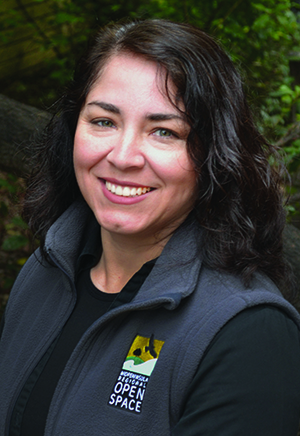 A Message from the General Manager
A Message from the General Manager
It Takes a Community to Care for Open Space
Nature is one of our best teachers, showing us how all living things are part of a larger community. For example, in the preserves this winter you may observe bees feeding on the nectar of blooming manzanita, which in turn depends on the bees’ buzzing vibration for pollination to produce seeds and regenerate.
Here at Midpen, we also depend on the contributions of our broad community to protect, restore and connect people to our natural ecosystem. Our community includes people from many different backgrounds and walks of life with diverse talents and expertise, who share common values around natural open space lands.
Our more than 110 volunteer docent naturalists and nature center hosts are working professionals and retirees who dedicate thousands of hours annually, enriching visitors’ experiences with greater knowledge and appreciation of our surrounding natural and cultural history. Recent staff additions to our Interpretation and Education Program are allowing us to expand our programs and engage even more people, including the next generation of environmental stewards.
Our more than 450 resource management, trail patrol and special project volunteers are hardworking seniors, scouts, school and community groups, corporate employees and supporters dedicated to making public open space preserves healthy and accessible.
Mutually beneficial partnerships with a variety of local organizations are also critical to fulfilling our mission and creating a more resilient and thriving region that benefits people, plants and animals. They include our long-standing land acquisition and funding partner POST, local fire departments, scientific researchers, youth conservation corps and a host of regional trail partners.
Our new grant-giving program, launched in 2019, is connecting us with new partners doing exciting and beneficial projects for the open space community. Through this work, we are supporting hands-on environmental education programs for students from low-income Bay Area schools and scientific studies on French broom impacts to native plant pollination and on the historic composition of bird nests that will inform our restoration work.
This holiday season, we extend our enduring gratitude for your support, and the many hands, hearts and minds working together as an open space community to successfully further Midpen’s mission.
With much appreciation,

Ana María Ruiz
General Manager
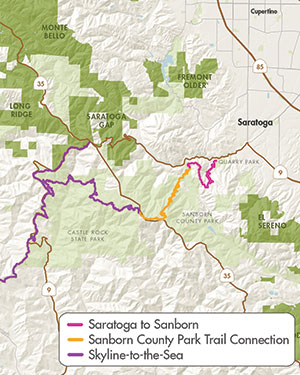
Trail Will Soon Link Saratoga to the Coast
Through funds from voter-approved Measure AA, Midpen has supported the design, environmental review and engineering required to construct a new 3.2-mile trail from Quarry Park to Sanborn County Park. The new trail will pass from Saratoga’s newly opened Quarry Park through San Jose Water Company land to Sanborn County Park, connecting to the Skyline-to-the-Sea Trail and ultimately to the Pacific Ocean.
As part of a regional vision and though partnerships like this one with City of Saratoga, Midpen is helping close gaps between existing trails, connecting people to more open space preserves, improving access for bicyclists and equestrians, and creating wildlife corridors that allow animals to move safely.
Construction is expected to span through 2020, with completion and opening of the trail later that year.
Celebrating 15 years of Service to the Coastside
As Midpen celebrates 15 years of partnership with the Coastside community, we are reflecting on what we’ve accomplished together and the opportunities on the horizon.
Looking back to the 1990s, as development pressure threatened the Coastside’s scenic beauty, rural character and agricultural heritage, residents expressed their support for extending the Midpeninsula Regional Open Space District boundaries to include the San Mateo County Coastside. In 2004, the coast to ridgeline from Montara to the San Mateo-Santa Cruz county line officially became Midpen’s Coastside Protection Area.
Since then, Midpen has preserved more than 11,000 acres of coastal open space and agricultural lands. With the 2014 voter approval of Measure AA, a $300 million 30-year bond, we have invested more than $16 million on the coast: restoring streams and redwood forests, enhancing sustainable agriculture and opening areas for low-impact outdoor recreation. Highlights include:
- Opening lower La Honda Creek Preserve to the public with 6 miles of hiking and equestrian trails.
- Protecting more than 1,200 acres of redwood forests, grasslands and watersheds.
- Restoring habitat in San Gregorio Creek for endangered coho salmon and steelhead trout.
- Completing new water systems, fencing and corrals to support conservation grazing.
We look forward to continuing our partnership with the Coastside community, protecting and restoring the natural and agricultural lands that contribute so much the area’s rural identity, natural beauty and quality of life.
Ravenswood Bay Trail to Connect Commuters and Communities
A new section of the San Francisco Bay Trail is currently under construction at Ravenswood Open Space Preserve. The trail will close a 0.6-mile critical gap on the peninsula, connecting 80 miles of continuous Bay Trail and providing important commute alternatives for cyclists. The new trail will also provide improved bay access for East Palo Alto and Menlo Park communities, and create opportunities for outdoor enthusiasts, including hikers, joggers and bicyclists.
The trail project includes a new boardwalk and bridge spanning the wetlands at the northern end of the preserve. An overlook along the boardwalk will include benches and interpretive signage, providing a great location for birdwatching along the easy-access trail.
Ravenswood Preserve contains a valuable and dynamic portion of the San Francisco Bay’s native salt marsh habitat, home to the federally endangered Ridgway’s rail and salt marsh harvest mouse. The project, funded by Measure AA and grant funds from multiple partner organizations, includes wetlands enhancement along with the trail construction.
“We are improving habitat for local wildlife at the preserve by building refugia islands and improving transition zones,” Midpen Resource Management Specialist Karine Tokatlian said. “These areas provide a gradual slope that allows marsh-dependent species access, like the tiny salt marsh harvest marsh, to shelter on higher ground during high-tide events.”
Ravenswood Preserve is closed during construction. To avoid the endangered Ridgeway’s rail breeding season, construction activity in the wetland areas is limited to September through January. The preserve is scheduled to reopen in February 2020, with the new trail opening anticipated in summer 2020.
Find out more about the Ravenswood Bay Trail
Mountain Lion Family Travels Through Rancho San Antonio
 It’s no surprise that the Santa Cruz mountains are home to mountain lions. Scientists estimate 50 to 100 mountain lions inhabit the Santa Cruz Mountain range. What was a surprise, however, to Midpen wildlife biologists was a Rancho San Antonio Preserve visitor recording footage of three mountain lions nonchalantly trotting down a trail during daylight hours in close proximity to people. This unusual behavior — mountain lions typically avoid humans and are usually most active at dawn and dusk — prompted the closure of a few trails to establish a safe distance between the pumas and people. Additional lion activity then expanded the closure to the entire preserve on a busy summer weekend. “We proactively closed the preserve so that we could work with California Department of Fish and Wildlife to evaluate the situation and ensure the safety of both people and mountain lions,” Matt Chaney, wildlife biologist at Midpen, explained. “When the mountain lion family moved up into the hills, we reopened the preserve.”
It’s no surprise that the Santa Cruz mountains are home to mountain lions. Scientists estimate 50 to 100 mountain lions inhabit the Santa Cruz Mountain range. What was a surprise, however, to Midpen wildlife biologists was a Rancho San Antonio Preserve visitor recording footage of three mountain lions nonchalantly trotting down a trail during daylight hours in close proximity to people. This unusual behavior — mountain lions typically avoid humans and are usually most active at dawn and dusk — prompted the closure of a few trails to establish a safe distance between the pumas and people. Additional lion activity then expanded the closure to the entire preserve on a busy summer weekend. “We proactively closed the preserve so that we could work with California Department of Fish and Wildlife to evaluate the situation and ensure the safety of both people and mountain lions,” Matt Chaney, wildlife biologist at Midpen, explained. “When the mountain lion family moved up into the hills, we reopened the preserve.”
Rancho is by far Midpen’s most popular preserve (approximately 700,000 preserve users visits each year), drawing more than four times the visitors of Fremont Older Preserve, the second most popular with approximately 160,000 visits. With a steady stream of human traffic, coupled with the area’s abundance of deer, mountain lion sightings are more likely here than at other preserves. In addition, the preserve is boxed in by the Lehigh Permanente quarry to the south and urban neighborhoods to the north and east. These habitats are not as suitable for mountain lion movement, so lions passing through the area are more likely to end up in the preserve.
Under normal circumstances, mountain lion sightings are still rare in Midpen preserves. Should you see a mountain lion while hiking, stand tall, make noise, throw objects and pick up small children or pets without bending over. Back away slowly and leave the area at once. Never run from or turn your back to a mountain lion, as this may trigger the animal’s instinct to chase. We encourage all preserve visitors to remain alert and report any mountain lion sightings to a Midpen Ranger.
Midpen’s mission is to preserve and protect the natural environment, including native wildlife like mountain lions, and to provide for public enjoyment of the preserves. It’s a balance, and our goal is to allow mountain lions and visitors to safely share the preserve.
Learn more about mountain lions
Fetid Adder’s Tongue “The Stink Plant”
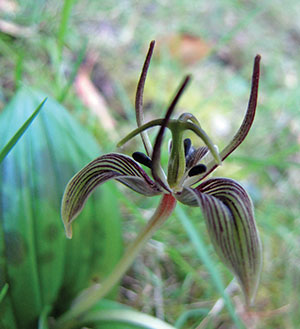 Fetid adder’s tongue (Scoliopus bigelovii) is an unusual little plant and its peculiarity is reflected in its name. To begin, the genus name Scoliopus means ‘’curved foot” and refers to the way the flower stalk bends, curves, and sprawls on the ground as the seed pod matures; the plant’s flower also has an unpleasant odor. The plant’s species name bigelovii honors John Milton Bigelow, a surgeon and botanist from Ohio who discovered the plant on Mount Tamalpais in 1854 as part of a U.S. Army surveying mission.
Fetid adder’s tongue (Scoliopus bigelovii) is an unusual little plant and its peculiarity is reflected in its name. To begin, the genus name Scoliopus means ‘’curved foot” and refers to the way the flower stalk bends, curves, and sprawls on the ground as the seed pod matures; the plant’s flower also has an unpleasant odor. The plant’s species name bigelovii honors John Milton Bigelow, a surgeon and botanist from Ohio who discovered the plant on Mount Tamalpais in 1854 as part of a U.S. Army surveying mission.
A member of the lily family, fetid adder’s tongue has two closely rolled green leaves at its base that later open out displaying their beautiful maroon-mottled leaves and three-angled flower stems that become limp and sprawling. Fetid adder’s tongue typically flowers in late winter and early spring (February to March); its flowers are pale green, lined with prominent dull reddish-brown, purple, maroon, or dark brown finely etched veins. The actual petals are smaller, threadlike, and up-curving. When the flower first appears, the flower stalk stands up straight, holding the flower above its two leaves.
After the flower has been pollinated, the fruit or seed pod begins to swell and the flower parts fall off. The weight of the growing pod causes the slender stalk to bend over, twist, and touch the ground, contributing to the plant’s other names – “slink pod” and “slink lily.” Instead of broadcasting their seeds like many flowering plants, the seed pod goes into the ground, while still attached to the “mother plant.” By the time the flowers have disappeared, the maroon-blotched leaves have grown quite large and will be present for months. This habit contributes to the name “adder’s tongue.” The “fetid” part of the name comes from the odor of the plant’s ill-scented flower. The flower’s nectary induces insects to enter and crawl around, with pollen generally deposited on the insect’s back. Likely attracted to the flower’s odor, fungus gnats and flies are the principle pollinators of fetid adder’s tongue.
Fetid adder’s tongue can be found in the coast ranges of northern California, often in deep-shaded, moist woods. This winter, visit the District’s Coal Creek, El Corte de Madera Creek, Purisima Creek Redwoods, Pulgas Ridge, Teague Hill or Thornewood Open Space Preserves to look for fetid adder’s tongue. For the really inquisitive visitor, kneel down to get a closer look at the plant and you might be able to get a whiff of the flower’s odor.
Information adapted from the Marin Chapter of the California Native Plant Society materials and Wikipedia.
Explore Your Open Space with Free Activities this Winter
If you're looking to explore a new preserve a docent-led activity is a great place to start. There are over 50 FREE docent-led activities this winter—come out and join us!

